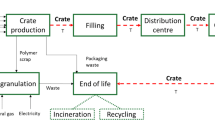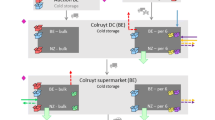Abstract
Purpose
The year-round supply of fresh fruit and vegetables in Europe requires a complex logistics system. In this study, the most common European fruit and vegetable transport packaging systems, namely single-use wooden and cardboard boxes and re-useable plastic crates, are analyzed and compared considering environmental, economic, and social impacts.
Methods
The environmental, economic, and social potentials of the three transport packaging systems are examined and compared from a life cycle perspective using Life Cycle Assessment (LCA), Life Cycle Costing (LCC) and Life Cycle Working Environment (LCWE) methodologies. Relevant parameters influencing the results are analyzed in different scenarios, and their impacts are quantified. The underlying environmental analysis is an ISO 14040 and 14044 comparative Life Cycle Assessment that was critically reviewed by an independent expert panel.
Results and discussion
The results show that wooden boxes and plastic crates perform very similarly in the Global Warming Potential, Acidification Potential, and Photochemical Ozone Creation Potential categories; while plastic crates have a lower impact in the Eutrophication Potential and Abiotic Resource Depletion Potential categories. Cardboard boxes show the highest impacts in all assessed categories. The analysis of the life cycle costs show that the re-usable system is the most cost effective over its entire life cycle. For the production of a single crate, the plastic crates require the most human labor. The share of female employment for the cardboard boxes is the lowest. All three systems require a relatively large share of low-qualified employees. The plastic crate system shows a much lower lethal accident rate. The higher rate for the wooden and cardboard boxes arises mainly from wood logging. In addition, the sustainability consequences due to the influence of packaging in preventing food losses are discussed, and future research combining aspects both from food LCAs and transport packing/packaging LCAs is recommended.
Conclusions
For all three systems, optimization potentials regarding their environmental life cycle performance were identified. Wooden boxes (single use) and plastic crates (re-usable) show preferable environmental performance. The calibration of the system parameters, such as end-of-life treatment, showed environmental optimization potentials in all transport packaging systems. The assessment of the economic and the social dimensions in parallel is important in order to avoid trade-offs between the three sustainability dimensions. Merging economic and social aspects into a Life Cycle Assessment is becoming more and more important, and their integration into one model ensures a consistent modeling approach for a manageable effort.





Similar content being viewed by others
References
ADEME (2000) Analyse du cycle de vie des caisses en bois, carton ondulé et plastic pour pommes (LCA of wooden boxes, cardboard boxes and plastic crates for apples). Agence de l'Environnement et de la Maîtrise de l'Energie. Derived from: http://www.ademe.fr/htdocs/actualite/dossier/pdf/acvs.pdf. Accessed 07 March 2012
Albrecht S, Beck T, Barthel LP, Fischer M, Deimling S, Baitz M (2009) The sustainability of packaging systems for fruit and vegetable transport in Europe based on life cycle-analysis—update 2009. University of Stuttgart, Dept. Life Cycle Engineering (GaBi) 2009. www.stiftung-mehrweg.de. Accessed 05 March 2012
Aworh OC (2010) Reducing postharvest losses of horticultural commodities in Nigeria through improved packaging. The World of Food Science, vol 8 (Robertson, G. L. Ed.), International Union of Food Science and Technology (IUFoST). http://www.worldfoodscience.org/cms/?pid=1005132&printable=1. Accessed 21 March 2012
Barthel L, Wolf MA, Eyerer P (2005) Methodology of life cycle sustainability for sustainability assessments. 11th Annual International Sustainable Development Research Conference (AISDRC), 06–08 June 2005, Helsinki, Finland
Barthel L, Albrecht S, Baitz M, Deimling S, Fullana I Palmer P, Gazulla C, Balazs, S, Des Abbayes C (2007) The sustainability of packaging systems for fruit and vegetable transport in Europe based on life cycle-analysis. University of Stuttgart, Dept. Life Cycle Engineering (GaBi) on behalf of Stiftung Initiative Mehrweg (SIM). www.plasticsconverters.eu/uploads/Final-Report-English-070226.pdf. Accessed 05 March 2012
Benoît C, Andrews ES, Barthel LP, Beck T, Ciroth A, Cucuzzella C, Gensch CO, Hébert J, Lesage P, Manhart A, Mazeau P, Mazijn B, Methot AL, Moberg A, Norris G, Parent J, Prakash S, Reveret JP, Spillemaeckers S, Ugaya CM, Valdivia S, Weidema Bo (2009) Guidelines for social life cycle assessment of products social and socio-economic LCA guidelines complementing environmental LCA and life cycle costing, contributing to the full assessment of goods and services within the context of sustainable development provided by the UNEP/SETAC Life Cycle Initiative. ISBN: 978-92-807-3021-0, DTI/1164/PA
Büsser S, Jungbluth N (2009) The role of flexible packaging in the life cycle of coffee and butter. Int J Life Cycle Assess 14(Suppl 1):S80–S91
Buzby JC, Wells HF, Axtman B, Mickey J (2009) Supermarket loss estimates for fresh fruit, vegetables, meat, poultry and seafood and their use in the ERS loss-adjusted food availability data. EIB-44, U.S. Dept. of Agriculture, Econ. Res. Serv. March 2009
Cagnot JF, Monier V, Le Doré, A (2000) Cost efficiency of packaging recovery systems: the case of France, Germany, the Netherlands and the United Kingdom. Final Report, Commission of the European Communities, ETD/98/502038, Taylor Nelson Sofres Consulting, Paris
Capuz S, Aucejo S et al. (2005) A comparative study of the environmental and economic characteristics of corrugated board boxes and reusable plastic crates in the long distance transport of fruit and vegetables, Spanish and English Version. Study performed by the Polytechnic University of Valencia in cooperation with the Packaging, Transport and Logistics Research Centre ITENE 2005
Cellura M, Longo S, Mistretta M (2012) Life cycle assessment (LCA) of protected crops: an Italian case study. J Clean Prod 28:56–62
Chonhenchob V, Singh SP (2003) A comparison of corrugated boxes and reusable plastic containers for mango distribution. Packag Technol Sci 16:231–237
Chonhenchob V, Singh SP (2005) Packaging performance comparison for distribution and export of papaya fruit. Packag Technol Sci 18:125–131
Euro Pool System (2008) Primary industry data. Euro Pool System International B.V. 2289 DJ Rijswijk, The Netherlands
FEFCO (2006) European Database for Cardboard Life Cycle Studies 2006, published by FEFCO (European Federation of Cardboard Manufacturers), GO (Groupement Européen des Fabricants de Papiers pour Ondulé) and ECO (European Containerboard Organisation)
Fraunhofer IML (2008) Fraunhofer Institute for Material Flow and Logistics. Expert data and judgement 2008
Fullana-i-Palmer P, Puig R, Bala A, Baquero G, Riba J, Raugei M (2011) From life cycle assessment to life cycle management: a case study on industrial waste management policy making. J Ind Ecol 15:458–475
GaBi (2008a) PE, LBP: GaBi4 software-system and databases for life cycle engineering. Copyright, TM. Stuttgart, Echterdingen, 1992–2008
GaBi (2008b) PE, LBP: GaBi4 LCWE Life Cycle Working Environment (Social database). Copyright, TM. Stuttgart, Echterdingen. www.gabi-software.com/fileadmin/Documents/lcwe.pdf
GROW (2008) GROW Verein für umweltfreundliche Holzverpackungen e.V., (Association for environmental friendly wooden packaging), 67133 Maxdorf, Germany. Personal communication (e-mail) with U. Groll: 21.10.2008
Guinée JB, Gorrée M, Heijungs R, Huppes G, Kleijn R, van Oers L, Wegener Sleeswijk A, Suh S, Udo de Haes HA, de Bruijn H, van Duin R, Huijbregts MAJ (2002) Life cycle assessment: an operational guide to the ISO standards. Kluwer, Dordrecht, The Netherlands
IFCO SYSTEMS (2008) Primary industry data. IFCO SYSTEMS GmbH, 82049 Pullach Germany
ISO (2006) Environmental management—life cycle assessment—principles and framework, 2006; German and English version DIN EN ISO 14040:2006
ISO (2006) Environmental management—life cycle assessment—requirements and guidelines (ISO 14044:2006); German and English version DIN EN ISO 14044:2006
ISO (2000) Environmental management—life cycle assessment—examples of application of ISO 14041 to goal and scope definition and inventory analysis. German and English (currently under revision)
Levi M, Cortesi S, Vezzoli C, Salvia G (2011) A comparative life cycle assessment of disposable and reusable packaging for the distribution of Italian fruit and vegetables. Packag Technol Sci 24:387–400
López Camelo AF (2004) Manual for the preparation and sale of fruits and vegetables. From field to market. Rome, Food and agriculture organization of the United Nations. ISBN 92-5-104991-2
Makishi Colodel C, Kupfer T, Barthel L, Albrecht S (2009) R&D decision support by parallel assessment of economic, ecological and social impact - Adipic acid from renewable resources versus adipic acid from crude oil. J Ecol Econ 68(6):1599–1604
Remón S, Venturini ME, Lopez-Buesa P, Oria R (2003) Burlat cherry quality after long range transport: optimisation of packaging conditions. Innov Food Sci Emerg Technol 4:425–434
RPCC (2004) Life cycle inventory of re-usable plastic containers and display-ready corrugated containers used for fresh produce. Applications Report prepared for Re-usable Plastic Container Coalition (RPCC) by Franklin Associates. RPCC: Prairie Village, Kansas, USA
Silvenius F, Katajajuuri JM, Grönman K, Soukka R, Koivupuro HK, Virtanen Y (2011) Role of Packaging in LCA of Food Products. In: Finkbeiner M (ed) Towards Life Cycle Sustainability Management. Springer. ISBN 978-94-007-1898-2, pp 359–370
Singh SP (1992) New package system for fresh berries. Packag Technol Sci 5:3–10
Singh SP, Chonhenchob V, Singh J (2006) Life cycle inventory and analysis of re-usable plastic containers and display-ready corrugated containers used for packaging fresh fruits and vegetables. Packag Technol Sci 19:279–293
Wagner & Partner SA (2003) Transportgebinde im ökologischen Vergleich; Eine Projektstudie im Auftrag der IWIS, Interessengemeinschaft der Wellkartonindustrie Schweiz, www.iwis.ch
Author information
Authors and Affiliations
Corresponding author
Additional information
Responsible editor: Hans-Jürgen Garvens
Rights and permissions
About this article
Cite this article
Albrecht, S., Brandstetter, P., Beck, T. et al. An extended life cycle analysis of packaging systems for fruit and vegetable transport in Europe. Int J Life Cycle Assess 18, 1549–1567 (2013). https://doi.org/10.1007/s11367-013-0590-4
Received:
Accepted:
Published:
Issue Date:
DOI: https://doi.org/10.1007/s11367-013-0590-4




